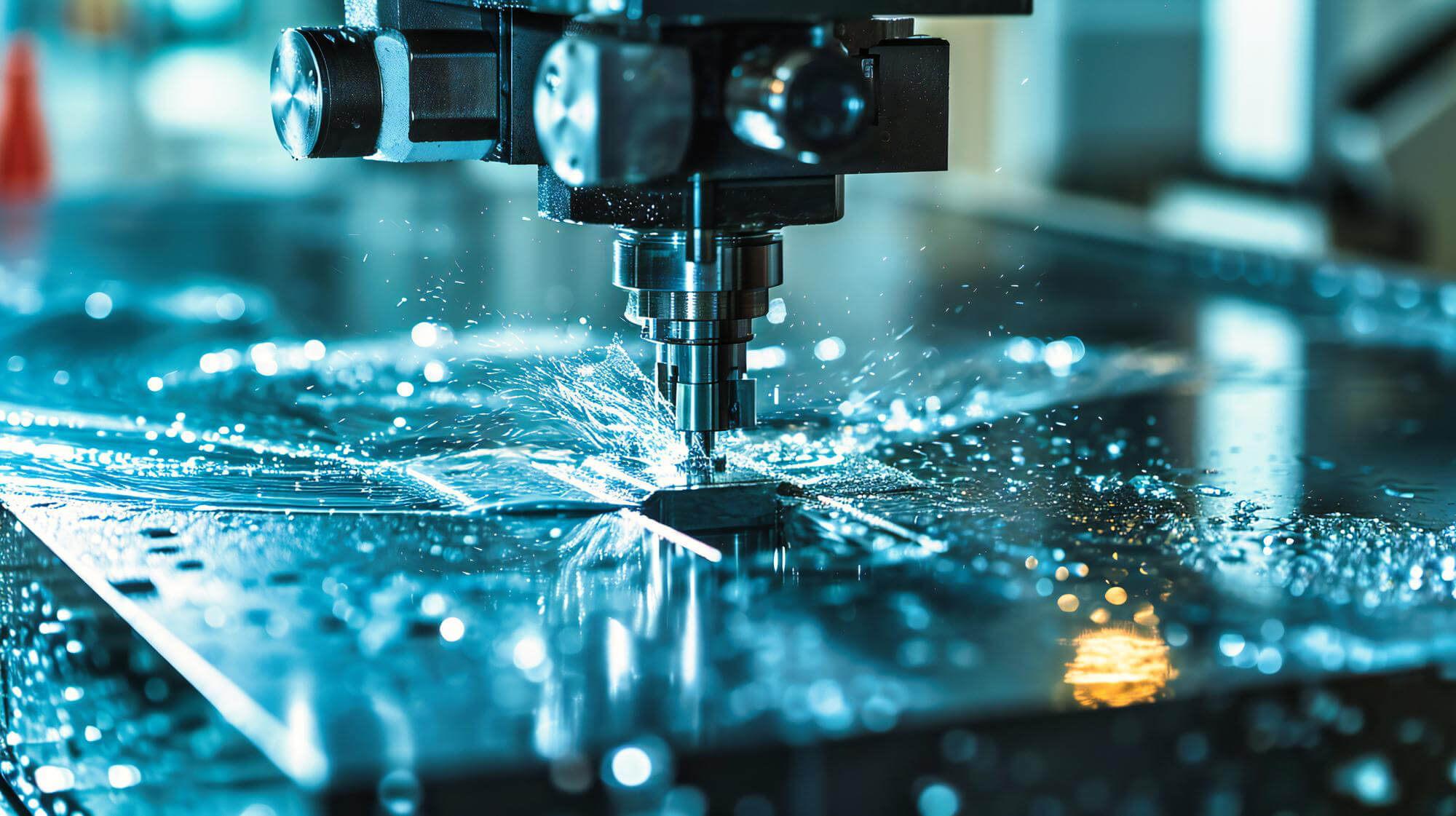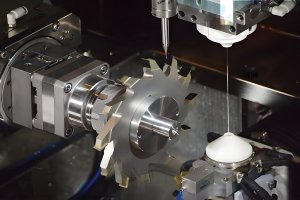Composite materials like Carbon Fiber Reinforced Polymer (CFRP) and Glass Fiber Reinforced Polymer (GFRP) have revolutionized industries such as aerospace, automotive, and marine. Their unique combination of strength, light weight, and resistance to corrosion makes them ideal for high-performance applications. However, machining these materials, especially through CNC milling, presents significant challenges. This article delves into the efficient milling strategies for composite CNC machined parts, focusing on tooling, coatings, and process optimization to achieve the best results.
Introduction to Composite Materials in CNC Machining
Before we dive into the specifics of milling strategies, it’s crucial to understand what makes composite materials like CFRP and GFRP unique. Composites are engineered materials made from two or more constituent materials with significantly different physical or chemical properties. These materials work together to produce a material with characteristics different from the individual components.
Why Use Composites?
- High Strength-to-Weight Ratio: Composites like CFRP are much lighter than metals like steel and aluminum while offering similar or even superior strength. This is particularly beneficial in industries where reducing weight without compromising strength is crucial, such as in aerospace or automotive applications.
- Corrosion Resistance: Unlike metals, composites do not corrode, making them ideal for environments where exposure to moisture or chemicals is a concern.
- Fatigue Resistance: Composites can withstand repeated cycles of stress and strain without significant degradation, which is vital for structural components.
- Tailored Properties: Composites can be engineered to exhibit specific properties by adjusting the composition and orientation of the fibers, making them highly versatile for various applications.
These properties make composites the material of choice for many high-performance applications, but they also introduce significant challenges in the machining process, particularly during milling.
Challenges in Milling Composite Materials
Milling composite materials like CFRP and GFRP is not as straightforward as milling metals. The heterogeneous nature of composites, where fibers and the matrix have different mechanical properties, makes the machining process complex. Here are some key challenges:
- Tool Wear: The abrasive nature of fibers, particularly carbon fibers, causes rapid tool wear. This not only increases costs due to frequent tool changes but also impacts the quality of the machined parts.
- Delamination: During milling, the layers of composite materials can separate, leading to delamination. This issue is particularly problematic for structural parts that require high precision, such as custom flanges.
- Heat Generation: The milling process generates significant heat, which can cause the polymer matrix in composites to degrade, affecting the surface finish and overall strength of the part.
- Fiber Pullout and Burr Formation: Improper milling can lead to fibers being pulled out of the matrix, resulting in rough surfaces and the formation of burrs, which require additional finishing processes.
- Vibration and Noise: The difference in material properties between the fibers and the matrix can cause vibrations during milling, leading to poor surface quality and increased noise.
Tool Selection for Milling Composite Materials
The selection of the right tool is critical when milling composite materials. The tool must be able to handle the abrasive nature of the fibers while maintaining a sharp edge to minimize damage to the composite structure. Here are some common tools used in composite milling:
1. Polycrystalline Diamond (PCD) Tools
PCD tools are among the most popular choices for milling composite materials due to their exceptional hardness and wear resistance. PCD tools are particularly effective in minimizing tool wear when machining abrasive materials like CFRP.
2. Carbide Tools
Carbide tools, particularly those with specialized coatings, are also widely used for milling composites. They offer a good balance between cost and performance, though they typically wear faster than PCD tools.
3. Diamond-Coated Tools
Diamond-coated tools provide a cost-effective alternative to solid PCD tools. The diamond coating offers excellent wear resistance, though the tools may lose their coating over time, especially when machining highly abrasive materials.
Table 1: Comparison of Tool Materials for Composite Milling
| Tool Material | Wear Resistance | Cost | Suitability for CFRP | Typical Applications |
|---|---|---|---|---|
| Polycrystalline Diamond (PCD) | High | High | Excellent | Aerospace components, high-precision parts |
| Carbide | Moderate | Moderate | Good | Automotive parts, general milling |
| Diamond-Coated | High | High | Excellent | Complex geometries, extended tool life |
| High-Speed Steel (HSS) | Low | Low | Poor | Not recommended for composites |
Tool Geometry and Its Impact on Milling
The geometry of the cutting tool plays a crucial role in the effectiveness of the milling process. Proper tool geometry can reduce cutting forces, minimize heat generation, and prevent issues like delamination. Key aspects of tool geometry include:
1. Cutting Edge Sharpness
A sharp cutting edge is essential for clean cuts in composite materials. Dull edges can lead to increased cutting forces, higher temperatures, and a greater likelihood of delamination.
2. Helix Angle
The helix angle of the tool affects the cutting action and chip removal. A higher helix angle can improve chip evacuation and reduce cutting forces, but it may also increase the risk of delamination if not optimized.
3. Number of Flutes
The number of flutes on the tool impacts chip removal and surface finish. Tools with more flutes can produce a finer finish but may generate more heat due to increased friction.
4. Relief Angle
The relief angle helps reduce friction between the tool and the workpiece, which is critical in preventing heat buildup and reducing tool wear.
Coatings for Milling Tools
Tool coatings play a significant role in extending the life of the tool and improving the quality of the machined part. In composite milling, coatings must provide both wear resistance and thermal stability. Here are some common coatings used in milling tools for composites:
1. Titanium Aluminum Nitride (TiAlN)
TiAlN is a popular coating for milling tools used in composite materials. It provides excellent wear resistance and can withstand high temperatures, making it ideal for high-speed milling operations.
2. Diamond-Like Carbon (DLC)
DLC coatings offer a combination of hardness and low friction, which reduces tool wear and prevents material adhesion. DLC is particularly effective in reducing burr formation in CFRP milling.
3. Aluminum Titanium Nitride (AlTiN)
AlTiN coatings provide superior oxidation resistance and can operate at higher temperatures than TiAlN. This makes AlTiN ideal for applications where heat generation is a concern.
4. Chemical Vapor Deposition (CVD) Diamond
CVD diamond coatings offer the best wear resistance and are particularly effective for high-precision applications. However, they are more expensive than other coatings, making them suitable for specialized applications.
Table 2: Comparison of Coatings for Composite Milling Tools
| Coating | Wear Resistance | Thermal Stability | Cost | Best For |
|---|---|---|---|---|
| Titanium Aluminum Nitride (TiAlN) | High | High | Moderate | General-purpose milling |
| Diamond-Like Carbon (DLC) | Moderate | Moderate | High | Burr reduction, smooth finishes |
| Aluminum Titanium Nitride (AlTiN) | High | Very High | Moderate | High-temperature applications |
| Chemical Vapor Deposition (CVD) Diamond | Very High | High | Very High | High-precision, extended tool life |
Milling Process Optimization for Composite Materials
To achieve the best results when milling composite materials, it’s not just about choosing the right tools and coatings—optimizing the milling process itself is equally important. Key factors to consider include cutting parameters, machine settings, and cooling methods.
1. Cutting Parameters
Cutting parameters such as speed, feed rate, and depth of cut must be carefully optimized to balance tool life and surface quality.
- Cutting Speed: Higher cutting speeds can reduce cutting forces and improve surface finish, but they also increase heat generation, which can degrade the composite material.
- Feed Rate: A higher feed rate reduces the time the tool is in contact with the material, lowering heat buildup and reducing the risk of delamination. However, too high of a feed rate can lead to poor surface quality.
- Depth of Cut: Shallow cuts are generally preferred when milling composites to minimize the forces on the material and reduce the risk of fiber pullout and delamination.
Table 3: Recommended Cutting Parameters for CFRP Milling
| Parameter | Range | Impact on Tool Life | Impact on Surface Quality |
|---|---|---|---|
| Cutting Speed | 1000-3000 m/min | Moderate | High |
| Feed Rate | 0.05-0.15 mm/tooth | High | Moderate |
| Depth of Cut | 0.5-2.0 mm | High | High |
2. Machine Settings
The settings on the CNC machine itself can greatly influence the milling process. Vibration control, spindle speed, and toolpath strategy all play a role in achieving high-quality results.
- Vibration Control: Excessive vibration can lead to poor surface finish and tool wear. Ensure the machine is properly calibrated and consider using vibration-damping technologies.
- Spindle Speed: Adjusting spindle speed based on the material properties and tool used can optimize the cutting process. Higher spindle speeds are generally preferred for composites, but must be balanced with cutting speed and feed rate.
- Toolpath Strategy: The toolpath strategy, including the direction of milling (climb or conventional) and the approach to corners and edges, can impact the quality of the final part. Climb milling is generally preferred for composites to reduce delamination.
3. Cooling Methods
Effective cooling is essential when milling composites to prevent heat buildup that can degrade the material. However, traditional coolants may not always be suitable for composites, so alternative methods must be considered.
- Air Cooling: Compressed air can be used to cool the tool and workpiece while also removing chips from the cutting area. This method is effective for most composite materials and does not introduce moisture, which could affect the material’s properties.
- Minimum Quantity Lubrication (MQL): MQL involves using a small amount of lubricant, typically in mist form, to reduce friction and heat. This method can be effective for composites but requires careful control to prevent excessive lubrication.
Case Study: Milling CFRP Flanges for Aerospace Applications
To illustrate the practical application of these strategies, let’s explore a case study where a supplier was tasked with milling CFRP flanges for an aerospace application.
The Challenge
The supplier needed to produce CFRP flanges that were lightweight, strong, and capable of withstanding the high stresses encountered in aerospace environments. The key challenges included minimizing tool wear, preventing delamination, and achieving a high-quality surface finish.
The Solution
The supplier selected PCD tools for their exceptional wear resistance and ability to maintain sharp cutting edges. The tools were coated with CVD diamond to further extend their life and improve surface quality. The milling process was optimized with a cutting speed of 2500 m/min, a feed rate of 0.1 mm/tooth, and a depth of cut of 1.0 mm. Air cooling was used to manage heat without affecting the material properties.
The Results
The CFRP flanges met all the required specifications, with no signs of delamination and an excellent surface finish. Tool wear was minimal, and the CVD diamond coating proved highly effective in maintaining the tool’s performance over the production run.
Table 4: Case Study Results
| Metric | Value |
|---|---|
| Cutting Speed | 2500 m/min |
| Feed Rate | 0.1 mm/tooth |
| Depth of Cut | 1.0 mm |
| Tool Wear | Minimal |
| Delamination | None |
| Surface Finish Quality | Excellent |
Milling composite materials like GFRP and CFRP presents unique challenges, but with the right tools, coatings, and process optimization, it’s possible to achieve high-quality CNC machined parts. By understanding the factors that influence tool wear, surface quality, and machining efficiency, suppliers can produce components that meet the stringent requirements of industries such as aerospace and automotive. For buyers, selecting a supplier with expertise in composite machining and using the latest technologies is key to ensuring the best results.
Other Articles You Might Enjoy
- Mastering Cavity Milling Techniques for CNC Machined Parts
Cavity milling is a common operation in CNC machining centers. It involves removing material from a closed area defined by its boundary lines, which can include sidewalls and a bottom…
- Unraveling the World of CNC Machined Plastic Parts(CNC machined plastic parts Mabel)
Modern innovations have taken traditional manufacturing methods to new heights. One such innovation that stands out is Computer Numerical Control (CNC) machining, a process used extensively in various industries from…
- CNC Machined Plastic Parts: An In-depth Overview(CNC machined plastic parts Norman)
Computer Numeric Control (CNC) machining is an advanced manufacturing process where pre-programmed software dictates the movement of factory machinery and tools. These applications can carry out complicated manufacturing tasks with…
- Enhancing CNC Machining with Smart Alloys: Shape Memory Metals vs. Traditional Alloys
Introduction to CNC Machining Computer Numerical Control (CNC) machining stands as a cornerstone in modern manufacturing, enabling the precise and automated shaping of materials. This technology relies heavily on the…
- Face Milling Essentials for CNC Machining Parts
Face milling is an essential operation in CNC machining, aimed at controlling the height of the workpiece and ensuring a smooth surface finish. This process often uses multi-tooth cutters, known…
- Why Is CNC Milling Preferred for Manufacturing Precision Titanium Parts?
Titanium is renowned for its exceptional properties, making it a preferred material for manufacturing precision parts in various industries such as aerospace, medical, and automotive.






